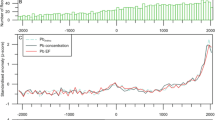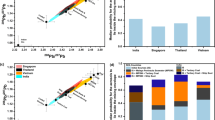Abstract
Lead emissions originate primarily from the anthropogenic lead cycle, and research into their characteristics, such as species type, provides essential information for pollution control. A dynamic model for global lead emissions has been established, and their emissions and temporal accumulations were estimated in this study based on the evolution of the lead cycle over 70 years. An inventory of the emissions species was obtained after identifying their physiochemical transformations. The 2010 emissions were 3.56 Mt, with 65 % coming from waste management and recycling. The main species were PbSO4 (42.5 %), PbO2 (16.2 %), and PbS (8.3 %). Between 1930 and 2010, the total lead emissions were 173.8 Mt, mainly from waste management and recycling (48 %), production (26 %), and use (20 %). The main species were PbSO4, PbO, Pb, and PbS, and together, they accounted for 61.2 % of the total emissions. Over time, species, such as tetraethyl lead and Pb, declined, but PbO2 and PbSO4 increased.





Similar content being viewed by others
References
Alberto S, Marcello V, Luca R, Franco B, Severyn S, Antonio S, Ignazio F (2012) Combination of beehive matrices analysis and ant biodiversity to study heavy metal pollution impact in a post-mining area (Sardinia Italy). Environ Sci Pollut R 19(9):3977–3988
Chen WQ, Graedel TE (2012) Anthropogenic cycles of the elements: a critical review. Environ Sci Technol 46(16):8574–8586
Chen JM, Tong YP, Xu JZ, Liu XL, Li YL, Tan MG, Li Y (2012) Environmental lead pollution threatens the children living in the Pearl River Delta region, China. Environ Sci Pollut R 19(8):3268–3275
CNIA (China Nonferrous Metals Industry Association) (2009) China nonferrous metals industry 60 years. Central South University Press, Changsha
Dahodwalla H, Heart S (2000) Cleaner production options for lead-acid battery manufacturing industry. J Clean Prod 8(2):133–142
DiFrancesco CA, Smith GR, Gabby PN, Guberman DE (2012) Lead statistics (1900–2011), http://minerals.usgs.gov/ds/2005/140/ds140-lead.pdf. Accessed 8 September 2013
Eckelman MJ, Graedel TE (2007) Silver emissions and their environmental impacts: a multilevel assessment. Environ Sci Technol 41(17):6283–6289
Editorial Staff of the Yearbook of the Nonferrous Metals Industry. China Nonferrous Metals Industry Yearbook (1990–2010). China Nonferrous Metals Industry Yearbook Press, Beijing. (in Chinese)
Elshkaki A, Van der Voet E, Van Holderbeke M, Timmermans V (2004) The environmental and economic consequences of the developments of lead stocks in the Dutch economic system. Resour Conserv Recycl 42:133–154
Elshkaki A, van der Voet E, Van Holderbeke M, Timmermans V (2009) Long-term consequences of non-intentional flows of substances: modelling non-intentional flows of lead in the Dutch economic system and evaluating their environmental consequences. Waste Manag 29(6):1916–1928
Genaidy AM, Sequeira R, Tolaymat T, Kohler J, Rinder M (2008) An exploratory study of lead recovery in lead-acid battery lifecycle in US market: an evidence-based approach. Sci Total Environ 407(1):7–22
Glöser S, Soulier M, Tercero Espinoza LA (2013) Dynamic analysis of global copper flows. Global stocks, postconsumer material flows, recycling indicators, and uncertainty evaluation. Environ Sci Technol 47:6564–6572
Graedel TE, Cao J (2010) Metal spectra as indicators of development. PNAS 107(49):20905–20910
Guo X-Y, Zhong J-Y, Song Y (2009) Substance flow analysis of lead in china. J Beijing Univ Technol 35(11):1554–1561 (in Chinese)
International Lead and Zinc Study Group (ILZSG) (1992) Principal uses of lead and zinc 1960–1990, London
International Lead and Zinc Study Group (ILZSG) (2005) Lead and zinc: end use industry statistical supplement, 1994–2003, London
International Lead and Zinc Study Group (ILZSG) (2005) Principal uses of lead and zinc 2005, London
International Lead and Zinc Study Group (ILZSG) (2008) Principal uses of lead and zinc 2005, London
International Lead Association (2014) Lead statistics world totals, http://www.ila-lead.org/lead-facts/statistics. Accessed 1 January 2014
Jolly R, Rhin C (1994) The recycling of lead-acid batteries: production of lead and polypropylene. Resour Conserv Recycl 10(1–2):137–143
Kavlak G, Graedel TE (2013a) Global anthropogenic tellurium cycles for 1940–2010. Resour Conserv Recycl 76:21–26
Kavlak G, Graedel TE (2013b) Global anthropogenic selenium cycles for 1940–2010. Resour Conserv Recycl 73:17–22
Li Z-M, Tan X-B, Wu X-Z, Liu Y-N (2009) The influence of mixing process on leady paste properties. Battery 46(1):18–20 (in Chinese)
Li Q, Cheng HG, Zhou T, Lin CY, Guo S (2012) The estimated atmospheric lead emissions in China, 1990–2009. Atmos Environ 60:1–8
Liang J, Mao JS (2014a) A dynamic analysis of environmental losses from anthropogenic lead flow and their accumulation in China. Trans Nonferrous Metals Soc China 24(4):1125–1133
Liang J, Mao J-S (2014b) Speciation analysis of lead losses from anthropogenic flow in China. Environ Sci 35(3):1191–1197 (in Chinese)
Lohm U, Anderberg S, Bergbäck B (1994) Industrial metabolism at the national level: a case-study on chromium and lead pollution in Sweden. In: Ayres RU, Semonis UE (eds) Industrial Metabolism. United Nations University Press, Tokyo, pp 1880–1980
Manceau A, Boisset M, Sarret G, Hazemann J, Mench M, Cambier P, Prost (1996) Direct determination of lead speciation in contaminated soils by EXAFS spectroscopy. Environ Sci Technol 30(5):1540–1552
Mao JS, Dong J, Graedel TE (2008a) The multilevel cycle of anthropogenic lead I. Methodol Resour Conserv Recycl 52(8–9):1058–1064
Mao JS, Dong J, Graedel TE (2008b) The multilevel cycle of anthropogenic lead. II. Results and discussion. Resour Conserv Recycl 52(8–9):1050–1057
Mao JS, Cao J, Graedel TE (2009a) Losses to the environment from the multilevel cycle of anthropogenic lead. Environ Pollut 157:2670–2677
Mao JS, Dong J, Graedel TE (2009b) Lead in-use stock. J Ind Ecol 13(1):112–126
Mao JS, Ma L, Liang J (2014) Changes in the functions, forms and locations of lead during its anthropogenic flows to provide services. Trans Nonferrous Metals Soc China 24(1):233–242
Nriagu JQ, Pacyna JM (1988) Quantitative assessment of worldwide contamination of air, water and soils by trace metals. Nature 333:134–139
Ordoñez I, Rahe U (2013) Collaboration between design and waste management: can it help close the material loop? Resour Conserv Recycl 72:108–117
Ostergren JD, Brown GE Jr, Parks GA, Tingle TN (1999) Quantitative speciation of lead in selected mine tailings from Leadville, CO. Environ Sci Technol 33(10):1627–1636
Pacyna JM, Scholtz MT, Li YF (1995) Global budget of trace metal sources. Environ Rev 3:145–159
Rauch JN, Pacyna JM (2009) Earth’s global Ag, Al, Cr, Cu, Fe, Ni, Pb, and Zn cycles. Global Biogeochem Cycle 23:1–16
Sakata K, Sakaguchi A, Tanimizu M, Takaku Y, Yokoyama Y, Takahashi Y (2014) Identification of sources of lead in the atmosphere by chemical speciation using X-ray absorption near-edge structure (XANES) spectroscopy. J Environ Sci 26(2):343–352
Schwarz K, Pickett S, Lathrop RG, Weathers KC, Pouyat RV, Cadenasso ML (2012) The effects of the urban built environment on the spatial distribution of lead in residential soils. Environ Pollut 163:32–39
Sen IS, Bernhard PE (2012) Anthropogenic disturbance of element cycles at the Earth’s surface. Environ Sci Technol 46(16):8601–8609
Shah P, Strezov V, Nelson F (2009) X-ray absorption near edge structure spectrometry study of nickel and lead speciation in coals and coal combustion products. Energy Fuel 23(3):1518–1525
Shi DZ, Wu WX, Lu SY, Chen T, Huang HL, Chen YX, Yan JH (2008) Effect of MSW source-classified collection on the emission of PCDDs/Fs and heavy metals from incineration in China. J Hazard Mater 153(1–2):685–694
Smith GR (2004) Lead recycling in the United States in 1998, http://infohouse.p2ric.org/ref/45/44143.pdf. Accessed 20 August 2013
Smith DR, Flegal AR (1995) Lead in the biosphere: recent trends. Ambio 24(1):21–23
Tukker A, Buist H, van Oers L, van der Voet E (2006) Risks to health and environment of the use of lead in products in the EU. Resour Conserv Recycl 49:89–109
Wang J-M, Li R-R (2003) The refining technology at home and abroad. Nonferrous Resour Recycl 3:11–14 (in Chinese)
Woodward A (2006) How products are made, http://www.madehow.com/Volume-2/Lead.html#b#ixzz2pa2pAl6o. Accessed 8 July 2014
Zhang XW, Yang LS, Li YH, Li HR, Wang WY, Ge QS (2011) Estimation of lead and zinc emissions from mineral exploitation based on characteristics of lead/zinc deposits in China. Trans Nonferrous Metals Soc China 21(11):2513–2519
Zhu XF, Yang JK, Gao LX, Yang N, Sun XJ, Zhang W, Wang Q, Li L, He DS, Kumar RV (2013) Preparation of lead carbonate from spent lead paste via chemical conversion. J Hazard Mater 134–135:47–53
Acknowledgments
This work was supported by the National Natural Science Foundation of China (General Program) under grant no. 41171361 entitled The Anthropogenic Transfer and Transformation of Lead and the Quantitative Analysis on Environmental Accumulated Lead Emissions.
Conflict of interest
All of the authors declare that they have no conflicts of interest. The authors confirm that this is an original submission which has not been published previously or submitted to any other journal.
Author information
Authors and Affiliations
Corresponding author
Additional information
Responsible editor: Vera Slaveykova
Rights and permissions
About this article
Cite this article
Liang, J., Mao, J. Source analysis of global anthropogenic lead emissions: their quantities and species. Environ Sci Pollut Res 22, 7129–7138 (2015). https://doi.org/10.1007/s11356-014-3878-4
Received:
Accepted:
Published:
Issue Date:
DOI: https://doi.org/10.1007/s11356-014-3878-4




